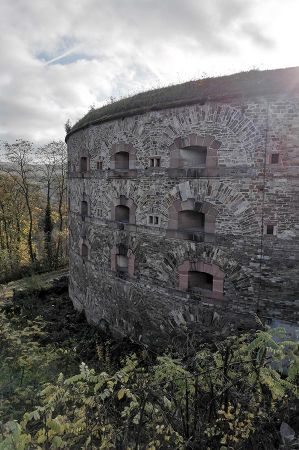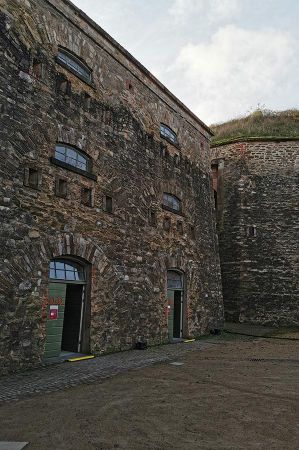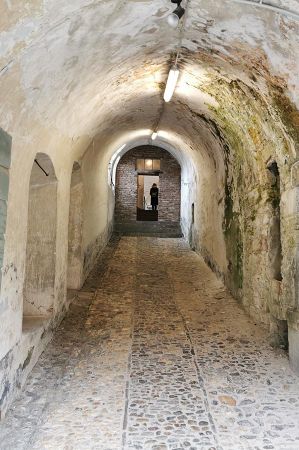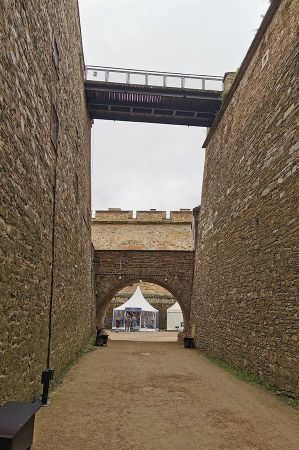Off to Ehrenbreitstein Fortress – by cable car
- Written by Portal Editor
Our days in Koblenz were, as is unfortunately so often the case, far too short, because we had actually intended the climb to Ehrenbreitstein Fortress to be a hike that would also allow us to see other sights along the way.
Well, it is what it is and the experience of taking the Koblenz cable car up to the fortress is truly remarkable. The weather conditions limited visibility somewhat, but that didn't bother us much either. The drive up to the 118-meter-high rock with its huge fortress, the view of Koblenz, the Deutsches Eck with the confluence of the Rhine and Moselle was a special experience.
 The settlement of the Ehrenbreitstein dates back to around 4000 BC. proven. During excavations in spring 2005, the remains of a pile ditch from the 10th century BC were found under the Great Traverse (more precisely: under the eastern domed hall). Found. It was part of a Bronze Age fortification that was located on the southern part of the mountain spur. At a point only about 30 meters wide, the palisade, reinforced with earth from behind, secured the southern part of the mountain spur against the only access option in the north. During an archaeological excavation in 2003, the remains of a Celtic noble residence were discovered under the flag tower.
The settlement of the Ehrenbreitstein dates back to around 4000 BC. proven. During excavations in spring 2005, the remains of a pile ditch from the 10th century BC were found under the Great Traverse (more precisely: under the eastern domed hall). Found. It was part of a Bronze Age fortification that was located on the southern part of the mountain spur. At a point only about 30 meters wide, the palisade, reinforced with earth from behind, secured the southern part of the mountain spur against the only access option in the north. During an archaeological excavation in 2003, the remains of a Celtic noble residence were discovered under the flag tower.
Finds of slingshot projectiles, vessels and coins date back to Roman times, which indicate that the rock was used by the Romans. On the southern rocky spur there was a late Roman burgus from around 250 to 450 to protect the mouth of the Moselle, the Roman roads and the nearby Limes. Ceramic finds from the Carolingian period suggest a medieval fortification in the 8th or 9th century.
From Ehrenbertstein to Ehrenbreitstein
 The Konradiner Ehrenbert had a castle built on the rock around the year 1000, whose name “Ehrenbertstein” became “Ehrenbreitstein” over time. In the 11th century, the castle became the property of the Archbishop of Trier, Poppo, whose successor steadily enlarged the complex. In the 12th century, the castle hill was enriched with Helfenstein Castle, the seat of the later counts. In the 15th century, under Archbishop Richard von Greiffenclau, it was expanded into a fortress protected against artillery.
The Konradiner Ehrenbert had a castle built on the rock around the year 1000, whose name “Ehrenbertstein” became “Ehrenbreitstein” over time. In the 11th century, the castle became the property of the Archbishop of Trier, Poppo, whose successor steadily enlarged the complex. In the 12th century, the castle hill was enriched with Helfenstein Castle, the seat of the later counts. In the 15th century, under Archbishop Richard von Greiffenclau, it was expanded into a fortress protected against artillery.
During the Thirty Years' War the castle experienced a lot of changes in ownership. In 1797, French troops besieged the fortress, but were only able to force a surrender through starvation in 1799. In 1801 they had the fortress blown up. In 1815, after the Rhenish areas of Kurtrier were transferred to the Kingdom of Prussia as a result of the Congress of Vienna, King Friedrich Wilhelm III ordered. the expansion of Koblenz into a fortress city. One of the largest fortresses in Europe was built.
 The fortress system consists of the city fortifications of Koblenz and Ehrenbreitstein as well as their upstream fortifications in the form of fortresses, flasks, redoubts and forts, which have been partially preserved or have almost completely disappeared over time due to razing and later demolition (e.g. Emperor Alexander's fortresses). are. Visual connections made it easier to secure each other between the individual buildings located on the hills and in the lower levels around the city.
The fortress system consists of the city fortifications of Koblenz and Ehrenbreitstein as well as their upstream fortifications in the form of fortresses, flasks, redoubts and forts, which have been partially preserved or have almost completely disappeared over time due to razing and later demolition (e.g. Emperor Alexander's fortresses). are. Visual connections made it easier to secure each other between the individual buildings located on the hills and in the lower levels around the city.
The Ehrenbreitstein Fortress, the second largest surviving fortress in Europe, was built in its current form between 1817 and 1828. Today Ehrenbreitstein is the only surviving Prussian fortress from the 19th century, the largest historic fortress in Europe after Gibraltar and part of the Upper Middle Rhine Valley UNESCO World Heritage Site. Its location and facilities, easy access by cable car and the spectacular view, e.g. B. can be enjoyed from the wooden Rhein-Mosel-Blick viewing platform, making the Ehrenbreitstein Fortress one of the most popular excursion destinations in Rhineland-Palatinate.
Today, in addition to the Koblenz State Museum with its diverse exhibitions, the fortress also houses the “German Army Memorial” and the Koblenz Youth Hostel.
Ehrenbreitstein Fortress Cultural Centre and Koblenz State Museum
 The cultural centre fortress Ehrenbreitstein | Koblenz State Museum shows exhibitions in four houses in the fortress grounds with a focus on photography, archaeology, viticulture and enjoyment as well as economic and cultural history. The oldest exhibit can be found in the House of Archaeology. Together with the Koblenz State Archaeology Department, the State Museum presents traces of human life on the Middle Rhine and Moselle since prehistory and early history in a permanent exhibition.
The cultural centre fortress Ehrenbreitstein | Koblenz State Museum shows exhibitions in four houses in the fortress grounds with a focus on photography, archaeology, viticulture and enjoyment as well as economic and cultural history. The oldest exhibit can be found in the House of Archaeology. Together with the Koblenz State Archaeology Department, the State Museum presents traces of human life on the Middle Rhine and Moselle since prehistory and early history in a permanent exhibition.
Exciting permanent and temporary exhibitions await visitors in the House of Cultural History at the Upper Castle Courtyard. The annual exhibitions on topics such as technology, cultural and economic history are particular highlights in the exhibition program of the Koblenz State Museum.
 The House of Photography enriches its offering with numerous temporary exhibitions by national and international photographers.
The House of Photography enriches its offering with numerous temporary exhibitions by national and international photographers.
In the Haus des Genusses, guests get to know the “WeinReich Rhineland-Palatinate” as well as the country's special culinary delights in the temporary exhibitions.
A diverse museum educational program for young and old accompanies all exhibitions.
Based on the history of the Ehrenbreitstein Fortress, you will find a so-called free field of fire in the fortress park; the route here follows the underground mine passages. Next to it, wide lawns invite you to stroll. The multi-story, barrier-free viewing platform "Rhein-Mosel-Blick" offers a magnificent view of the vast surrounding area of the city of Koblenz.
 Also in the fortress park is the Fort Bleidenberg climbing playground - a movement-oriented adventure area for children, young people and adults. Play and climbing landscapes, huge tree houses at lofty heights, an “endless climbing wall” and a climbing labyrinth as well as swings and trampolines invite you to play and run around. The extensive lawns are perfect for relaxing.
Also in the fortress park is the Fort Bleidenberg climbing playground - a movement-oriented adventure area for children, young people and adults. Play and climbing landscapes, huge tree houses at lofty heights, an “endless climbing wall” and a climbing labyrinth as well as swings and trampolines invite you to play and run around. The extensive lawns are perfect for relaxing.
Please read as well:
Koblenz cable car with a view of the Ehrenbreitstein Fortress
Deutsches Eck in Koblenz - a symbolic place
New Year's Eve - the next turn of the year is coming!
-
 Fortress Ehrenbreitstein next to Koblenz
Fortress Ehrenbreitstein next to Koblenz
Fortress Ehrenbreitstein next to Koblenz
Fortress Ehrenbreitstein next to Koblenz
-
 Fortress Ehrenbreitstein next to Koblenz
Fortress Ehrenbreitstein next to Koblenz
Fortress Ehrenbreitstein next to Koblenz
Fortress Ehrenbreitstein next to Koblenz
-
 Fortress Ehrenbreitstein next to Koblenz
Fortress Ehrenbreitstein next to Koblenz
Fortress Ehrenbreitstein next to Koblenz
Fortress Ehrenbreitstein next to Koblenz
-
 Fortress Ehrenbreitstein next to Koblenz
Fortress Ehrenbreitstein next to Koblenz
Fortress Ehrenbreitstein next to Koblenz
Fortress Ehrenbreitstein next to Koblenz
-
 Fortress Ehrenbreitstein next to Koblenz
Fortress Ehrenbreitstein next to Koblenz
Fortress Ehrenbreitstein next to Koblenz
Fortress Ehrenbreitstein next to Koblenz
-
 Fortress Ehrenbreitstein next to Koblenz
Fortress Ehrenbreitstein next to Koblenz
Fortress Ehrenbreitstein next to Koblenz
Fortress Ehrenbreitstein next to Koblenz
-
 Fortress Ehrenbreitstein next to Koblenz
Fortress Ehrenbreitstein next to Koblenz
Fortress Ehrenbreitstein next to Koblenz
Fortress Ehrenbreitstein next to Koblenz
-
 Fortress Ehrenbreitstein next to Koblenz
Fortress Ehrenbreitstein next to Koblenz
Fortress Ehrenbreitstein next to Koblenz
Fortress Ehrenbreitstein next to Koblenz
-
 Fortress Ehrenbreitstein next to Koblenz
Fortress Ehrenbreitstein next to Koblenz
Fortress Ehrenbreitstein next to Koblenz
Fortress Ehrenbreitstein next to Koblenz
-
 Fortress Ehrenbreitstein next to Koblenz
Fortress Ehrenbreitstein next to Koblenz
Fortress Ehrenbreitstein next to Koblenz
Fortress Ehrenbreitstein next to Koblenz
-
 Fortress Ehrenbreitstein next to Koblenz
Fortress Ehrenbreitstein next to Koblenz
Fortress Ehrenbreitstein next to Koblenz
Fortress Ehrenbreitstein next to Koblenz
-
 Fortress Ehrenbreitstein next to Koblenz
Fortress Ehrenbreitstein next to Koblenz
Fortress Ehrenbreitstein next to Koblenz
Fortress Ehrenbreitstein next to Koblenz
-
 Fortress Ehrenbreitstein next to Koblenz
Fortress Ehrenbreitstein next to Koblenz
Fortress Ehrenbreitstein next to Koblenz
Fortress Ehrenbreitstein next to Koblenz
-
 Fortress Ehrenbreitstein next to Koblenz
Fortress Ehrenbreitstein next to Koblenz
Fortress Ehrenbreitstein next to Koblenz
Fortress Ehrenbreitstein next to Koblenz
-
 Fortress Ehrenbreitstein next to Koblenz
Fortress Ehrenbreitstein next to Koblenz
Fortress Ehrenbreitstein next to Koblenz
Fortress Ehrenbreitstein next to Koblenz
-
 Fortress Ehrenbreitstein next to Koblenz
Fortress Ehrenbreitstein next to Koblenz
Fortress Ehrenbreitstein next to Koblenz
Fortress Ehrenbreitstein next to Koblenz
-
 Fortress Ehrenbreitstein next to Koblenz
Fortress Ehrenbreitstein next to Koblenz
Fortress Ehrenbreitstein next to Koblenz
Fortress Ehrenbreitstein next to Koblenz
-
 Fortress Ehrenbreitstein next to Koblenz
Fortress Ehrenbreitstein next to Koblenz
Fortress Ehrenbreitstein next to Koblenz
Fortress Ehrenbreitstein next to Koblenz
-
 Fortress Ehrenbreitstein next to Koblenz
Fortress Ehrenbreitstein next to Koblenz
Fortress Ehrenbreitstein next to Koblenz
Fortress Ehrenbreitstein next to Koblenz
-
 Fortress Ehrenbreitstein next to Koblenz
Fortress Ehrenbreitstein next to Koblenz
Fortress Ehrenbreitstein next to Koblenz
Fortress Ehrenbreitstein next to Koblenz
-
 Fortress Ehrenbreitstein next to Koblenz
Fortress Ehrenbreitstein next to Koblenz
Fortress Ehrenbreitstein next to Koblenz
Fortress Ehrenbreitstein next to Koblenz
https://www.alaturka.info/en/germany/rhineland-palatinate/6459-off-to-ehrenbreitstein-fortress-by-cable-car#sigProId08c3cc96c8

